Biopsychology - ALL
1/190
There's no tags or description
Looks like no tags are added yet.
Name | Mastery | Learn | Test | Matching | Spaced |
|---|
No study sessions yet.
191 Terms
Biological Rhythms
What are biological rhythms?
Distinct patterns of changes in body activity that relate to cyclical time periods/changes in environment
Biological Rhythms
What are the 3 types of biological rhythm?
Circadian
Infradian
Ultradian
Biological Rhythms
What are the rhythms controlled by?
Endogenous pacemakers
Exogenous Zeitgebers
Biological Rhythms
What are endogenous pacemakers?
Mechanisms within the body that govern internal biological rhythms
Biological Rhythms
What are exogenous zeitgebers?
External changes in the environment
Biological Rhythms
What are circadian rhythms + example?
Approx. 24 hour duration
eg: sleep/wake cycle
Biological Rhythms
How do endogenous pacemakers control circadian rhythm (sleep/wake cycle)?
Suprachiasmatic nucleus (SCN) - connected to visual cortex and receives info about light
Pineal gland - releases melatonin which induces relaxation (sleepy)
Adrenal gland - releases cortisol which induces alternes (wakes up)
Biological Rhythms
DeCoursey et al (2000) - EP circadian
destroyed SCN connections in brains of 30 chipmunks who were then returned to natural habitat for 80 days
found: sleep/wake cycle disappeared, awake same time as predators (died) → supports idea of EP controlling circadian rhythms
Biological Rhythms
Siffre case study - EP circadian
caves: 2 months in alps + 6 months in Texas
in absence of natural light, sleep/wake cycle was 25 hours
suggests endogenously controlled as cycle similar length
Issue: had artificial light
Biological Rhythms
How do exogenous Zeitgebers control circadian rhythm?
Light - provides info for SCN
Social cues - eg: meal times, clocks
Biological Rhythms
Campbell and Murphy (1998) - EZ circadian
woke 15 participants at various times and shone a light on the back of their knees
produced a deviation of the usual sleep/wake cycle by up to 3 hours
Issue: findings never been replicated, small sample
Biological Rhythms
What are ultradian rhythms + example?
Duration of less than 24 hours
eg: sleep cycle
Biological Rhythms
How do endogenous pacemakers control ultradian rhythms?
5 sleep stages that span 90mins
1+2 = light sleep, easily woken, brainwaves become slower + more rhythmic, slowing further as sleep becomes deeper
3+4 = difficult to rouse, deep sleep, slow waves with great altitude
5 = REM (rapid eye movement) sleep, brain activity speeds up
Biological Rhythms
What waves are produced in each stage?
1 + 2 = alpha waves + beta waves
3 + 4 = delta waves
5/REM = alpha waves
Biological Rhythms
Dement - EP ultradian
Used EEG
Found dreaming correlated with REM activity in 9 participants
Issue: population validity + correlational
Biological Rhythms
What does BRAC stand for?
basic rest activity cycle
Biological Rhythms
BRAC - EP ultradian
Kleitman referred to 90min cycle found during sleep as BRAC
move through stages of alertness, not sleep
only can concentrate for 90mins
towards end we fatigue, lose resources and concentration
Biological Rhythms
What are infradian rhythms + example?
Duration greater than 24 hours
eg: menstrual cycle
Biological Rhythms
How do endogenous pacemakers control infradian rhythms (menstrual cycle)?
controlled by changes in hormone levels which regulate ovulation
during each cycle there is an increase in oestrogen/progesterone/FSH/LH
Biological Rhythms
(EVALUATION TOO) Stern and McClintock (1998) - EZ infradian
samples of pheromones taken from 9 women by cotton pads under pits for 8 hours
treated and given to other ps by rubbing pad on upper lip
68% experienced changes in cycles to be closer to their 'odour donor'
Issue: Trevathan et al (1993) didn't get same results → low reliability
Biological Rhythms
Seasonal affective disorder - EZ infradian
depression experienced in winter
main symptom is low mood
lack of light in winter = melatonin produced for longer, knock on effect on production of serotonin
Biological Rhythms
CR Evaluation: Siffre
Siffre found without natural light, his sleep/wake cycle only shifted to 25 hours (supports the idea that EPs = more important to the circadian rhythm) BUT low validity bcs artificial light/clock extraneous variables (EZs - social cues)
Biological Rhythms
CR Evaluation: Idividual differences
eg: age, effect CRs → adolescent's sleep/wake cycles appear to = 2hrs later vs adults → research in school that started lessons at 10 = positive health/academic outcomes → LIMITATION OF NOMOTHETIC APPROACH BCS NOT ALL LAWS APPLY EQUALLY TO EVERYONE
Biological Rhythms
CR Evaluation: alt explanation to light
Buhr et al (2010) suggests temperature controls body clock + light = trigger, bcs SCN transforms info about light -> neural messages that set body temp -> fluctuates over 24hrs -> controls body clock
BUT need more research
Biological Rhythms
CR Evaluation: Low validity of isolation studies
V rare for EPs to be free-running/unaffected by EZs so isolation studies like Siffre (since been questioned) are rare, and it might make little sense/have little validity to try to isolate them
Biological Rhythms
CR Evaluation: Practical application
negative impacts of desynchronisation (eg: shown that shift workers more likely to develop heart disease, lowered vigilance, more anxiety) can have economic impact by managing worker productivity
Biological Rhythms
CR - what is desynchronisation?
disrupting the rhythm so that EPs and EZs are no longer working in synchrony
Biological Rhythms
UR Evaluation: Supporting research
Tucker et al (2007) found 21 Ps over 11 days/nights found large significant differences in sleep duration/time to fall asleep/time in each sleep stage, meaning differences b/w people may be due to biology, not just circumstance.
Biological Rhythms
UR Evaluation: limitation of support
Tucker et al (2007) had a small sample size (21) meaning it's hard to generalise to the gen pop because they may not be representational (population validity).
Biological Rhythms
UR - Practical application
Understanding sleep cycle can be used in everyday routines to make lives easier - Believed 5 stages of sleep cycle take 90 mins, so if timed to wake up in first 2 stages will be more easily woken + feel more awake
Biological Rhythms
EP/CR Evaluation: Supporting research
Decoursey et al (2000) found when severed 30 chipmunks SCNs pathways + re-released them, most died bcs sleep/wake cycle changed + awake at same time as predators, supporting the idea that EPs play a role in maintaining our CRs
Biological Rhythms
EP/EZ/CR Evaluation: Supporting research issue (animal studies)
DeCourset et al (2000) used chipmunks to research effect of the EP SCN on the CR, yet generalised to humans BUT can't extrapolate results to humans bcs brains = more complex so can't assume will have same effect, so animal studies are limitations for research into EPs/EZs
Biological Rhythms
EZ/UR Evaluation - Small sample
Sleep studies generally have small sample sizes, (eg: Campbell + Murphy (1998) = 15 Ps to study effect of light on sleep cycle) so lack pop val bcs can’t be representative, lack generalisability
Biological Rhythms
EZ/EP/UR Evaluation: Practical application
Treatment for SAD = Phototherapy (light box simulates strong morning/evening light to reset melatonin levels - relieves 60% of symptoms (but placebos can have similar effects)) means melatonin levels increase, cortisol increase → boosts energy and increases serotonin (therefore increase mood)
Biological Rhythms
EPs/EZs Evaluation: I + D nature-nurture
follow on from low validity of isolation studies point
EPs = nature, EZ = nurture
EPs (eg: hormones) are internal factors (biological), and EZs (eg: light) are external factors (environment) so support interactionalist approach to nature-nurture debate
Neurons + synaptic transmission
what are excitatory neurotransmitters?
eg: noradrenaline
increase the likelihood of an impulse being transferred to the postsynaptic neuron
Neurons + synaptic transmission
what is excitatory post-synaptic potential (EPSP)?
What an excitatory neurotransmitter bonding with a postsynaptic receptor results in
Means the postsynaptic cell is more likely to fire
Neurons + synaptic transmission
what are Inhibitory neurotransmitters?
Eg: serotonin and GABA
decrease the likelihood of the presynaptic neuron firing
They calm the mind and the body
Neurons + synaptic transmission
what is inhibitory post-synaptic potential (IPSP)?
What an inhibitory neurotransmitter bonding with a postsynaptic receptor results in
means the postsynaptic cell is less likely to fire
Neurons + synaptic transmission
What is whether the cell fires or not determined by?
sum of the excitatory (+) and inhibitory (-) inputs
because a nerve can receive bother EPSPs and IPSPs at the same time
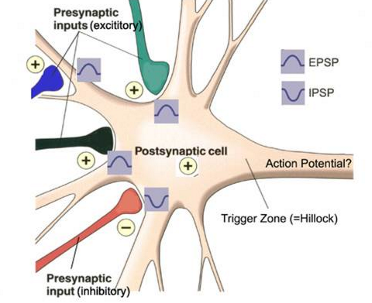
Neurons + synaptic transmission
What will the overall effect be on this nerve?
excitatory
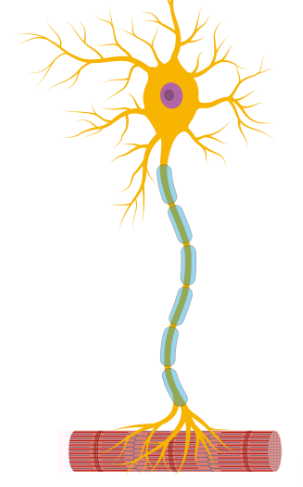
Neurons + synaptic transmission
What’s a Motor Neurone?
Send impulses from the brain to the muscles/effectors
Neurons + synaptic transmission
What’s a neurotransmitter?
Chemical substances that transmit nerve impulses across a synapse
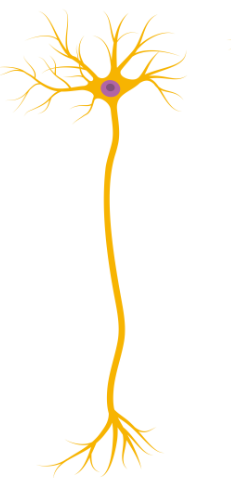
Neurons + synaptic transmission
What’s a Relay Neurone?
Allow sensory and motor neurones to communicate
found in the brain and CNS
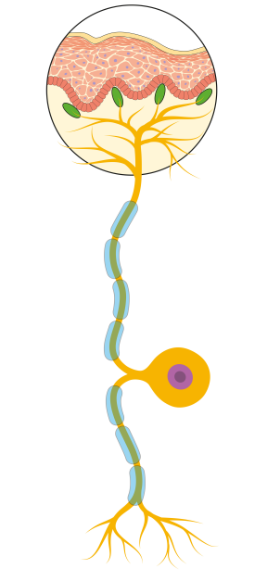
Neurons + synaptic transmission
What’s a Sensory Neurone?
Carry nerve impulses from sensory receptors to the spinal cord and the brain
Neurons + synaptic transmission
What’s a Synapse?
an area where 2 neurons come close enough to each other to pass chemical signals from one cell to another
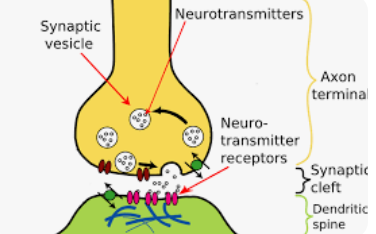
Neurons + synaptic transmission
What are Axon terminals?
The end of the neurone
synaptic transmission occurs
the signal is passed to the next neuron
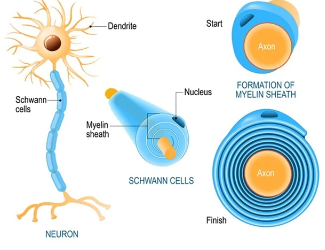
Neurons + synaptic transmission
What are Schwann cells?
made of myelin sheaths
Insulates the axon so the electrical impulses can travel faster

Neurons + synaptic transmission
What’s a Cell body/stoma?
Stores the Nucleus
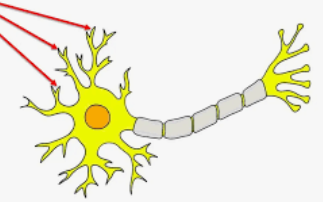
Neurons + synaptic transmission
What’s a dendrite?
receives signal from other neurons or from sensory receptor cells
Neurons + synaptic transmission
what are axons?
carry nerve impulses away from the cell body towards the axon terminals
Neurons + synaptic transmission
what are the qualities of a sensory neuron?
send information from the senses to the brain
short axons
long dendrites
cell body in the middle
Neurons + synaptic transmission
what are the qualities of a relay neuron?
mostly found in the brain/CNS and act between the sensory and motor neurons
long or short axon
short dendrites
Neurons + synaptic transmission
what are the qualities of motor neurons?
send messages via long axons from the brain to the muscles of effectors
long axons
short dendrites
Neurons + synaptic transmission
What’s Synaptic transmission?
process where a nerve impulse passes across the synaptic cleft from one neurone (the presynaptic neurone) to another (the postsynaptic neurone)
Neurons + synaptic transmission
what is reuptake?
after the impulse has been transferred any left over neurotransmitters are reabsorbed by the presynaptic neuron and stored for later impulses
Neurons + synaptic transmission
What is the first stage of synaptic transmission?
an electrical impulse (the action potential) travels down the Pre-synaptic axon terminal
Neurons + synaptic transmission
What is the second stage of synaptic transmission?
Impulse triggers the vesicles bind with its membrane and release the neurotransmitters into the synaptic cleft
Neurons + synaptic transmission
What’s the third stage of synaptic transmission?
the NTs diffuse across the synaptic gap where it binds to specific receptors on the surface of the postsynaptic neuron and triggers the action potential increase/decrease likelihood
Neurons + synaptic transmission
What’s the fourth stage of synaptic transmission?
the neurotransmitter are taken out of the synapse in 're-uptake'
Neurons + synaptic transmission
What’s a vesicle?
Small sacs in the pre-synaptic neurone that contain neurotransmitters
Neurons + synaptic transmission
What are ways the NTs may leave the synaptic cleft?
digested by enzymes and components used to make more NTs
taken back into presynaptic neurone via reuptake
Lateralisation
What is it called when one hemisphere is responsible for the other side of the body’s functions?
contralateral
Lateralisation
What is lateralisation?
theory that two brain hemispheres are functionally different + certain processes/behaviours are mainly controlled by one hemisphere over the other
Lateralisation
What hemisphere is visual centre in?
Both
Lateralisation
What hemisphere are the language centres in?
left
Lateralisation
What are the two hemispheres of the brain connected by?
Corpus callosum
Lateralisation
AO1 - what is the surgery that cuts out the corpus callosum, creating split brain patients?
commissurotomy
Lateralisation
Who did Sperry's experiment involve?
11 split brain patients who had commissurotomy
meant could research the extent to which each hemisphere was specialised + which brain functions were lateralised
Lateralisation
Sperry’s procedure:
RVF = right visual field
LVF = left visual field
image/word shown to RVF + same/different image/word shown to LVF (done by covering one eye + flashing the image/work for 1/10 of a second)
SO, patient could only process w/ one hemisphere
some trials had objects under a table they were allowed to touch
Lateralisation
Sperry’s findings:
Could describe what they saw if projected to RVF
Unable to do describe if projected to LVF, but could draw w/ left hand
Could attach verbal labels to objects presented to RVF
COULDN’T if presented to LVF, but could select relevant corresponding object from bag using left hand - eg: if shown a cigarette, picked up ash tray - (recognition by touch)
Lateralisation
Explain Sperry’s findings
L/RH = left/right hemisphere
Broca’s area (lang production) and Wernicke’s area (lang comprehension) = LH
LH controls right side of body + vice versa (is contralateral)
SO, patients couldn’t describe what was seen in LVF bcs processed by RH, so no lang centres
COULD draw/pick up w/ left hand bcs also controlled by RH → PROVES the RH was processing the info even though couldn’t verbalise it
Lateralisation
Evaluation: Supporting research
Sperry produced evidence that LH = associated w/ lang + analysis, RH = associated w/ emotion + synthesising info, + motor functions = contralateral → contributed to understanding of how the brain works + suggests certain functions are lateralised
Lateralisation
Evaluation: well controlled/replicability
Sperry’s methodology ensured info was only being received by 1 hemisphere (controlled) and was replicable→ meant could be confident in his conclusion about hemisphere laterisation bcs of well-controlled + useful procedure
Lateralisation
Evaluation: representation
Split brain patients are abnormal - all of Sperry’s Ps had history of epileptic fits, unique brain trauma bcs of commissurotomy, sample = 11 → conclusions need caution as unlikely to be completely representative of general population (lacks pop val)
Lateralisation
Evaluation: lab study
Lacks mundane realism (how well the experiment represents/mimics real life) → artificial task to cover eyes + look at images for 1/10 seconds → SO lacks generalisability to real life
Lateralisation
Evaluation: oversimplified
Sperry’s research led to growth in research that oversimplified/overemphasised lateralisation BUT hemispheres = in constant communication + research into neural plasticity/functional recovery (eg: Jody Miller - RH removed, but still able to use both side of body as if hadn't) demonstrates functions associated w/ one hemisphere can be effectively performed by other
Lateralisation
Evaluation: practical application
Rogers et al (2004) found lateralisation = associated w/ enhanced neural processing capacity (performing multiple tasks simultaneously) in chickens (eg: finding food + being vigilant for predators) → demonstrates how brain efficiency can be maximised in cognitive tasks
BUT issues w/ extrapolation from chicken’s → complex human brains
What are the 4 ways of studying the brain?
post mortem examinations
EEG
ERPS
fMRI
what are post mortem examinations?
what are they used for?
Involve dissecting the brain of a person who has died - can be comparing brain w/ disorder and ‘normal’ brain
to establish the underlying neurobiology of a particular behaviour
Why would post-mortem examinations be used?
What do they show?
to physically look at the internal structures of the brain
only way to study brain before modern brain scanning techniques
structural abnormalities that may explain disorders (Brown et al (1986) - schizophrenic patient had enlarged ventricles in brain)
Evidence for localisation (eg: Broca - 2 patients w/ speech production issues both had damage to same area (Broca’s area)) (Annese et al - HM’s inability to store new memories bcs of damaged hippocampus)
What are the pros of post-mortem examinations?
Allows for more detailed examination - couldn't be done while alive bcs too invasive
vital in early understanding of key processes in the brain (Broca + Wernicke both relied on PM examinations for research)
What are the cons of post-mortem examinations?
People die in a variety of circumstances/varying stages of disease which can influence the brain post-mortem - Eg: drug treatments, age, and time b/w death and examination are all confounding variables - so cause and effect cannot be confidently established
Small sample sizes → lack validity
What are fMRIs?
What are their uses?
Functional Magnetic Resonance Imaging scans are 3d scans that show changes in brain activity as they happen
Localisation of Function
Shows damaged/diseased areas of brain → diagnose medical problems
Study abnormal activity → Shegill et al (2001) show areas active for patient’s schizophrenic hallucinations
How do fMRIs work?
Magnetic field + radio waves
oxygenated blood react differently to magnetic field than deoxygenated
active areas of the brain require oxygenated blood
What are the pros of fMRIs?
Non-invasive -> doesn't rely on radiation
Has good spatial resolution (it produces images that depict detail by the mm so gives a clear pic of how activity is localised)
What are the cons of fMRIs?
Can only measure blood flow -cannot hone in on activity of individual neurons so difficult to tell what kind of activity is being shown - not truly quantitative measure
expensive compared to other neuroimaging techniques → small sample sizes → issues w/ generalising research
poor temporal resolution → 5s time lag after neural activity
What are ERPs?
Biopsychologists look at how an EEG wave pattern changes in response to a stimulus
This is known as an event-related potential
How are ERPs detected?
if a specific stimulus is presented, it produces a specific change in the wave pattern
Biopsychologists have identified different ERPs that are produced in response to different stimuli
What are uses of ERPs?
Used a lot in memory research - give biopsychologists clues to information processing in the brain
Research has shown differences in ERPs of people w/ certain disorders compared to healthy individuals (eg: Miltner et al (2000) - people w/ phobias had an ERP of a greater amplitude in response to objects they feared, compared to non-phobic individuals
What are the pros of ERPs?
(same of EEGs)
Provides specificity to the measurement of neural processes compared to EEGs
What are the cons of ERPs?
(same of EEGs)
Needs to be repeated many times for an average - time consuming
Often difficult to pick out from other electrical activity - so a large number of trails have to be conducted
What are EEGs?
How do they work?
An electroencephalogram shows the overall electrical activity of the brain
done by placing electrodes on scalp, when neurones fire they produce electrical fields which are recorded as brain waves, more electrons = stronger fields
what are the uses of EEGs?
Dement (1957) - correlated REM activity + dreaming
study schizophrenia (eg: Boutros et al (2008) meta-analysis - patients displayed abnormal EEG wave patterns compared to controls)
abnormal brain activity can show if person having seizure is epileptic
What are the pros of EEGs?
Non-invasive
Cheaper than fMRIs - can be more widely used in research - larger sample sizes/more confident generalisations
Useful in clinical diagnostics
high temporal resolution - detects activity within millisecond
What are the cons of EEGs?
Low ecological validity bcs in lab where (eg) sleep behaviours may not be the same as at home or a familiar environment
Poor spatial resolution - only provide generalised information - difficult to pinpoint the source of any activity if the locations are neighbouring
What’s the difference in EEGs and ERPs?
In an ERP a stimulus is presented to the P and the researcher looks for activity related to that stimulus
Localisation
what does anterior mean?
towards the front
Localisation
what does posterior mean?
towards the back
Localisation
what does superior mean?
above